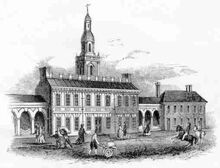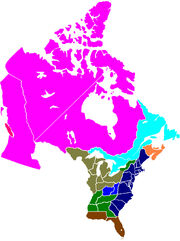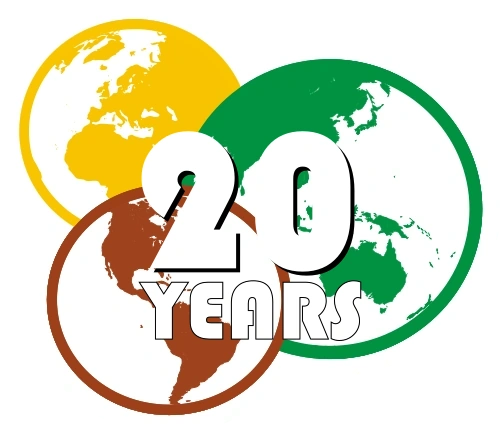| This Washington Shot at Murdering Town! article is a stub
|
| |||||
| Capital (and largest city) |
Philadelphia | ||||
| Language official |
English | ||||
| others | French | ||||
| Monarch | Elizabeth II | ||||
| Prime Minister | Sir Nigel Harrison | ||||
| Governor-General | Grant Black-Feather (Liberal Party) | ||||
| Area | area km² | ||||
| Population | 127,350,000 | ||||
| Established | April 16th, 1780 (Treaty of Philadelphia) | ||||
| Currency | Pound | ||||
The United Provinces of America (U.P.A) is a member state of the British Empire and Commonwealth (B.E.C) located in North America. Founded as a sub autonomous nation of 18th century Great Britain the United Provinces of America developed as a powerful member of the British influenced world. Expanding from its core of the Atlantic Coast of North America the U.P.A covers the breadth of the continent to the Atlantic, Pacific and Arctic Oceans. Informally, the U.P.A is referred to as British America or simply America. In its history the America benefited from British-led industrialization before becoming a technological leader in its own right. The culture of the U.P.A is a production of its colonial and industrial origins, being primarily influenced from Great Britain, West Africa and Amerindiana. Historically America hosted strong facial and regional identities. However, in the present, British America has created its own national identity defined more by the country's place in the New World and the current role within the British Empire and Commonwealth than its colonial past. America is a key exporter of grain and petroleum and a long time manufacturing base both empire and world wide. Since the 2000's the U.P.A has boomed as world leader in hi-tech and internet technology.
History
See:Colonial America
Origins 1780-1820

Union Hall in Philadelphia, Pennsylvania province, site of the creation of the U.P.A. The failed colonial rebellion also begun on the same site.
Following the defeat of a local colonial uprising 1777, the British Government took steps to ensure that the colonies would not revolt again. The United Provinces of America were formed on April 16th, 1780, from the 13 colonies and the Districts (later Provinces) of Maine and Vermont. The new nation was founded as an autonomous dependency to the British crown.
The early years of the United Provinces of America saw remnants of the colonial uprising, in remote places but no such riots again took place in major cities. The so called Founding Fathers of the rebellion were put on trial for treason in Philadelphia, while originally many of the leaders were threatened with hanging all but almost all of the major supporters of independence were eventually given parole. Famous Insurrectionists Benjamin Franklin and Thomas Jefferson were the only British citizens to be officially hanged as traitors. The war criminal Nathaniel Green was executed by firing squad for his destruction of New York.
Upon the signing of the Treaty of Philadelphia much of the colonial territory was still undeveloped, even unsettled in the case of the Appalachian Mountains. Much of this "open territory" was in reality inhabited by Amerindian or West Indian tribes. Despite the Incorporation Act of 1808 which recognized several Indian Tribes as legal provinces, the frontiers were lawless. To maintain peace the first army of National Colonial regulars worked with Indians to preserve their ancestral homelands from the flow of pioneers. Such moves created the backdrop for the Second Colonial Rebellion led by the famous frontiersman Andrew Jackson.
Close to the coast the societies and governments of all the colonies remained distinct from each other. The challenge of the New Union was to unify the land under on set of standards while cutting Imperial expenses and allowing for a degree of autonomy.Like Great Britain the new American parliament created a two party system modeled after their London forebears. American Conservatives and Liberals diverged on issues of religious tolerance and trade. At the time these parties meant little to the majority of men still unable to vote due to land ownership quotas.
From the turn of the 19th century the fledgling American economy began to boom as the first manufacturing plants founded by British investors generated sales of finished goods abroad. Freer trade allowed colonists to profit from trade with the French and the Spanish. With security provided and deficits reduced, wealthy colonists began to theorize of new public projects to bring different but growing economies together.
A country of many worlds 1820-1860
Different regions spread out over a breath of continent developed into subcultures. National and Imperial administration were frustrated by these developments in implementing a common law throughout the land. The British parliament encouraged the localization to prevent a unified dissent. The distinct cultures which emerged- Mercantile New England, the French North, Amerindiana, Islandville, the Cotton Belt and Back Country are still distinguished in the present.
The steady migration West despite the active effort by the Continental government to enforce various proclamation lines spilled over the continent. While some captured migrants were imprisoned or deported the ethnic English and Scottish settlement redefined the demographics of much of North America. The movement of people spilled over the western border into the Kingdom of Mexico. The illegal emigration west caught the ire of Spain. The problem turned into an international incident where London used the wayward settlers to gain concessions from Spain. British America's western frontier would become open to British citizens who promised to reside in the area for twenty years. The blended Spanish and English settlement of New Spain's Mississippi river valley resulted in the creation of the Louisianian Kingdom
Through 1850 the frontiers of the U.P.A also had designated penal colonies for prisoners both from America and England which moved north, and westwards as the country expanded. The end of the penal system released prisoners onto open land, creating the first towns for the central and Northwest frontiers. Gold rushes on North America's west coast brought the earliest settlers to some of the last unsettled lands on the continent.
As the country spread out over the continent regional economic interests threatened to split the provinces. The enduring slave trade continued to import African slaves to the British America against their will. The plantations of America's south grew on the mainland and the Caribbean. Contrasting with an industrial north and a west based on free farmers. Northern Americans and English home landers began to oppose the continuance of slavery on moral and economic grounds. While the British parliament itself was interested in abolishing slavery there was a reluctance to do so based on a strong personal relationship with the "Gentlemen Plantation owners". Slavery also became a new business for American tribes seeking to recover from the destruction of colonial times.
When the Slavery Controversy almost caused armed insurrection by the mainland Southern Provinces London intervened. Slavery was abolished in all British Crown dominions in 1845. Plantation owners were compensated handsomely for their freed slaves. Local unrest from white populations still occurred in the Carolinas, Georgia and the Caribbean provinces who feared the economic consequences of a free black population. Slavery continued on American processions of the East India Company.
The British North America Act, and the Territories Act of 1857 marked the final expansion of the U.P.A and set a stage for an independent culture- hardly seen before in history, as the abundance of space provided the land's citizens for a new found freedom irrespective of politics in Philadelphia or London.
Land of rolling countryside 1860-1900
The Formation of Identity 1900-1960
Rising Superpower 1960-1990
Steps toward the future
Government and Politics
The executive is theoretically the monarch but the Governor-General holds most of the power. The President-General is always the leader of the majority party in the House of Commons. The Governor-General has been reduced to the eyes and ears of the monarch.
The judicial is the Judge's Council, which is composed by the Chief Justice from the supreme court of each province.
The legislative is the Parliament of America. It is bicameral. The lower, larger house is the House of Commons. The upper, smaller house is the House of Senators.
Political Parties
Major Parties
- American Labour Party - left-wing - majority socialist party
- Progressive Party of America - left-wing - formed from parts of the Liberal and Conservative Parties in 1809
- American Liberal Party - centre
- American Conservative Party - right-wing - Was formed as America's first political party.
Minor Parties
- American People's Party - left wing - Radical Socialist, evolved out of extreme of American Labour Party
- American Green Party - left-wing green
- United Rationalist Party - centre-left - formed in 1836; has been a major party since the late 1840s; based on French Social-Rationalism principles
- Parti Laurentien (Laurentien Party) - Catholic centre - want Lower Canada to have more autonomy
- Christian Democratic Party - Protestant centre-right
- Freedom Party - centre-right - libertarian in spirit
Original Members (1780)

The historical progression of U.P.A expansion, color coded
- Connecticut
- Delaware
- Georgia
- Maine
- Maryland
- Massachusetts
- New Hampshire
- New Jersey
- New York
- North Carolina
- Pennsylvania
- Rhode Island
- South Carolina
- Vermont
- Virginia
Further Additions
Expansion Act (1804)
- Transylvania (1804)
- Vandalia (1804)
Incorporation Act (1808)
- Cherokee
- Chickasaw
- Choctaw
- Creek Confederation
- Iroquois Confederation
Florida Act (1819)
- East Florida
- West Florida
Nova Scotia Act (1823)
- Nova Scotia, along with St. John's Island (Prince Edward Island)
West Indies Act (1830)
- Antilles (Lesser Antilles) - Anguilla, Antigua, Barbuda, Dominica, Grenada, Montserrat, Nevis, St. Kitts, St. Lucia, St Vincent
- Bahamas
- Jamaica
- Trinidad and Tobago
Northwestern Act (1838)
- Anishinaabe
- Illinois Confederation
- Menominee
- Miami
- Potawatomi
- Shawnee
- Wisconsin Confederation
Canada's Act (1845)
- Newfoundland
- Upper Canada
- Lower Canada
British-North-America Act (1857)
- Belize
- District of Bermuda
- Guiana
- Miskito
- Vancouver Island
Territories Act (1857)
- Arctic Islands
- Northwest Territory
- Oregon Territory
- Rupert's Land
Culture
| |||
|---|---|---|---|
| Provinces | |||
|
Antilles | Bahamas | Belize | Connecticut | Delaware | East Florida | Georgia | Guiana | Jamaica | Lower Canada | Maine | Maryland | Massachusetts | New Hampshire | New Jersey | New York | Newfoundland | North Carolina | Nova Scotia | Pennsylvania | Rhode Island | South Carolina | Transylvania | Trinidad & Tobago | Upper Canada | Vandalia | Vermont | Virginia | Vancouver | West Florida | |||
| Nations | |||
|
Anishinaabe | Cherokee | Chickasaw | Choctaw | Creek | Illinois | Iroquois | Menominee | Miami | Miskito | Potawatomi | Shawnee | Wisconsin |
|||
| Districts and Territories | |||
|
Arctic Islands | Bermuda | Northwest Territory | Oregon Territory | Rupert's Land |
| |||
|---|---|---|---|
| Nations | |||
|
Australia | Great Britain | Ireland | India | Nigeria | South Africa | Sierra Leone | United Provinces of America | |||
| Protectorates | |||
| Colonies | |||
|
British Antarctic Territory | British Atlantic Territory | British Somaliland | Falkland Islands | Gambia |


